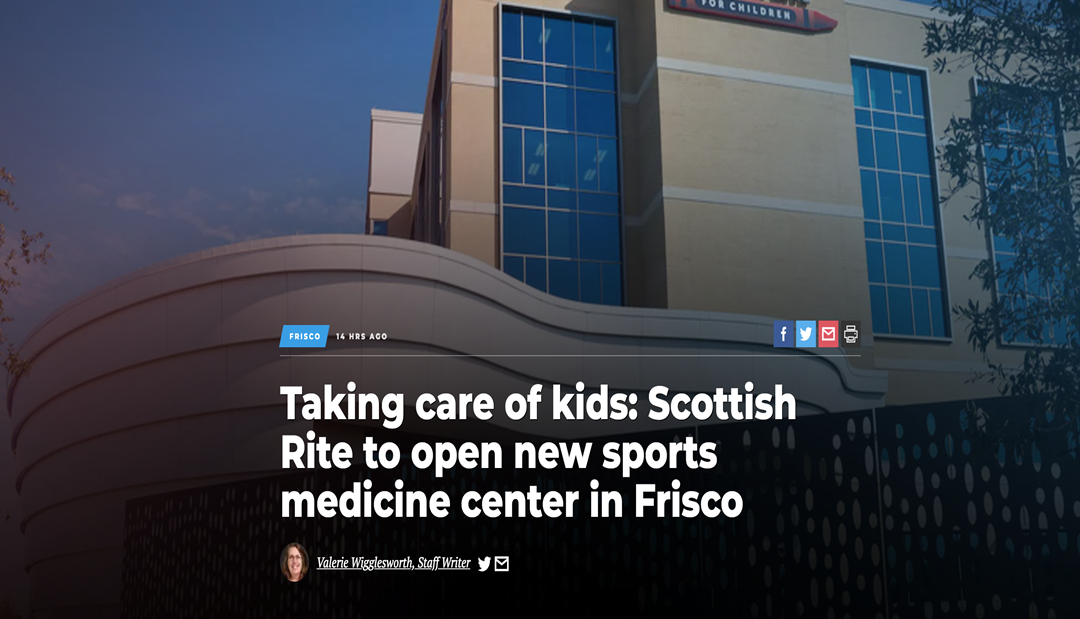View the original story on the Dallas Morning News website here.
FRISCO — In this boom-town that brands itself Sports City USA, a massive new hospital will aim to keep kids on the field.
Work crews have been putting the finishing touches on the new Scottish Rite for Children Orthopedic and Sports Medicine Center along the Dallas North Tollway at Lebanon Road. The 345,000-square-foot facility, which officially opens Oct. 10, will specialize in injury prevention and orthopedic issues such as broken bones or torn knee ligaments.
The hospital is the latest athletics-centric addition in Frisco, which is home to the Dallas Cowboys, FC Dallas, the Texas Legends basketball team and the Frisco RoughRiders baseball team, among others. And it will serve a market where youth sports are big; Men’s Journal in 2011 declared the city to be the nation’s Best Place to Raise an Athlete.
Jeremy Howell, vice president of the nonprofit Texas Scottish Rite Hospital for Children, said the hospital is about more than sports: “We’re giving kids back their childhood.”
The hospital, announced in 2014, will join a market that now features the Baylor Scott & White Sports Therapy & Research at The Star, which opened less than a mile to the south a few months ago. Next year, the Texas Health Hospital Frisco will open a few miles to the north.
The facility will be the second pediatric hospital for the nonprofit Scottish Rite, which was founded in Dallas in 1921 to treat children with polio. Over the years, the hospital’s efforts broadened to treat a variety of orthopedic conditions, such as scoliosis, clubfoot and limb-length differences.
Sports medicine is now the fastest growing sub-specialty for pediatric orthopedics. Part of that growth is due to the large number of children focusing on a single sport at an early age, resulting in overuse injuries.
The Scottish Rite’s Frisco campus — located along the tollway in what is known as the city’s North Platinum Corridor — will capitalize on that trend. But Howell said a second campus also makes sense now because about a quarter of Scottish Rite’s growing patient base lives north of Dallas.
Scottish Rite opened a temporary space in 2015 in Plano. It logged more than 18,000 patient visits in the fiscal year that ends Sept. 30. Those patients will move to the Frisco campus starting next month.
And the site has plenty of room for growth. Two operating rooms will be available starting next month. Four more can be equipped as needed. One floor will also remain mostly empty at the start.
The Frisco campus will have a state-of-the-art Movement Science Lab. Motion-capture cameras will analyze children as they run, jump, kick and throw. An outdoor soccer field, curved running track and artificial turf at the medical center will help test their limits.
The facility will offer day surgeries as well as physical therapy. A fracture clinic will accept walk-ins. The hospital will also have a rotation of clinics, including those for scoliosis and prosthetics.
Research will continue to play a large role for the teaching hospital. The medical center includes conference center space with a 155-seat lecture hall for training. The space will also be available to community groups.
“We’re always looking at new and better ways to take care of kids,” Howell said.
HKS Architects designed the pediatric hospital for efficiency. Meetings with doctors and nurses helped ensure the layout was functional. The pediatric hospital assigned different colors to define uses: blue for surgery and green for sports therapy, for example.
“This campus is all about movement,” said Bernita Beikmann, executive vice president for HKS Architects. “It’s rainbow from top to bottom.”
A Rainbow Dragon sculpture from artist Daniel Goldstein hangs from the ceiling in the entryway. And colored lights and panels can be found throughout.
Spaces are designed with families in mind — more natural lighting, comfortable seating, outlets for mobile devices, coffee bars. The idea is to take the anxiety out of their visit, Howell said.
“We don’t want it to feel, smell or look like a hospital,” he said.

